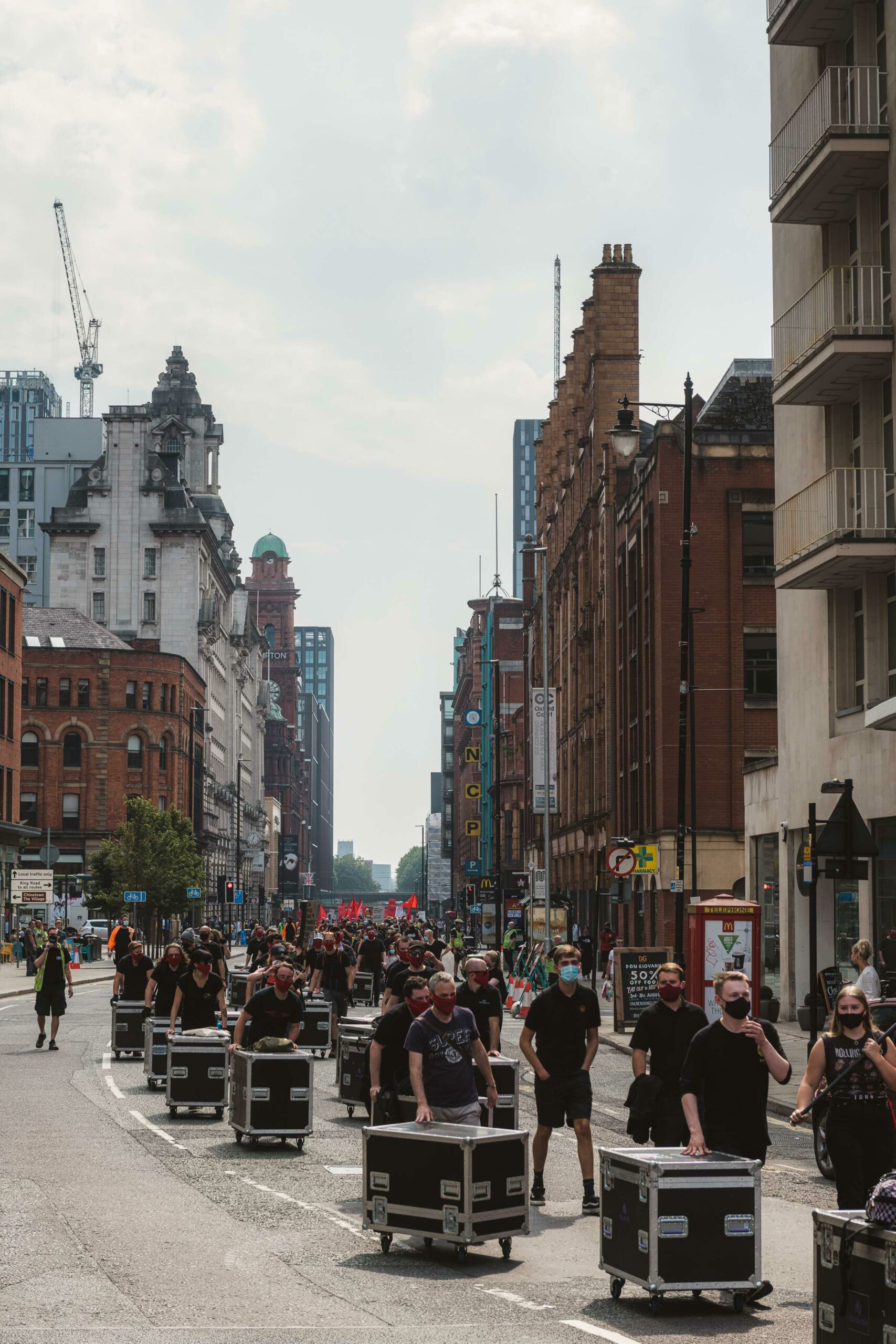Features
New Guidelines Implemented At UK Production Industry Protest

Jack Kirwin – 150 flight cases were pushed 1.2 miles through Manchester, England.
An honest statement by the professionals working in a vital part of live.
The live events and production community in Manchester organized a silent and distanced flight case march across the city Aug. 11, which culminated in a red flare exhibit, as part of the UK-wide #WeMakeEvents campaign.
The march coincided with the release of Tour Production Group’s (TPG) COVID-19 Working Guidance, which were implemented during the march.
In total, 150 flight cases were pushed 1.2 miles.
Over 1,000 freelancers and supply companies attended the regional protest in Manchester, England, aimed at getting the government to extend its furlough scheme, due to end in October, and allow access to grants in order to help save an estimated 114,000 jobs.
Production Manager Nick Gosling, who works with Nile Rodgers & Chic, is part of TPG’s committee and helped manage the event from his home in New Jersey.
On the ground in Manchester was production manager Nick Robinson, together with Ben Dawson as crew chief and flight case manager, and Event Trucking Services’ Alex Webster as transport coordinator.
It was a joint effort by local companies, including Go For Show for the mobile production offices, MLS, which provided barriers and pop up tents, and Tour Supply, which deployed consumables – with COVID-19 safety always at the forefront.
dbnAudile and Tube supplied flight cases with STS Touring Productions on standby for backup.
Gosling commented: “We used the guidance to determine how many cases could safely be put into each truck and then unloaded while undertaking the correct social distancing measures. In addition, the team also adhered to flight case cleaning protocols and implemented the correct PPE while on site at Manchester Academy.”
The venue marked the starting point of the march. “Cleaning the flight cases involved ‘loading in’ to Manchester Academy a day early to complete the hygiene tasks and flat packing of the the trucks so that each vehicle could be unloaded by a single crew member at a time,” Gosling explained.
Dawson added: “It was key that we kept contact with the cases to a minimum while making the situation workable. To achieve this, drivers tipped the truck and I worked the ramp to ensure that social distancing was consistent during offloading. From here, they were safely moved and then collected by a crew member. Face masks and gloves were used throughout this process to try and prevent cross contamination where possible.”

Jack Kirwin – The silent march ended with a red flare display.
Inside the venue, cases were sprayed liberally with disinfectant and organised in numerical order to streamline the registration process for contact track and tracing, then fed to the collection point in numerical order. There were also contingency plans against any case accidentally being handled by more than one person.
Tom Sheals-Barrett said: “What we’re used to doing day in / day out at work is uniting for a common goal, and that felt even more poignant following these months of separation. It was life-affirming to see everyone again. Morale was really high on the day and I personally think it’s been the most honest statement made by our industry to date.”
Gosling added: “Whilst this was a protest and not a live event as such, we take pride in organising teams and implementing protocols to a very high standard. Working under the Tour Production Group’s suggested conditions was no different.”
Dawson concluded: “It was interesting to see our own implementation of the guidance in action, to experience how it could affect working practices and the impact that could have in a ‘real’ environment.
“Assuming the same allowances can be made for time and trucking space, and the availability of appropriate disinfectants, PPE and policing of standards, this guidance could be workable in a show environment.”